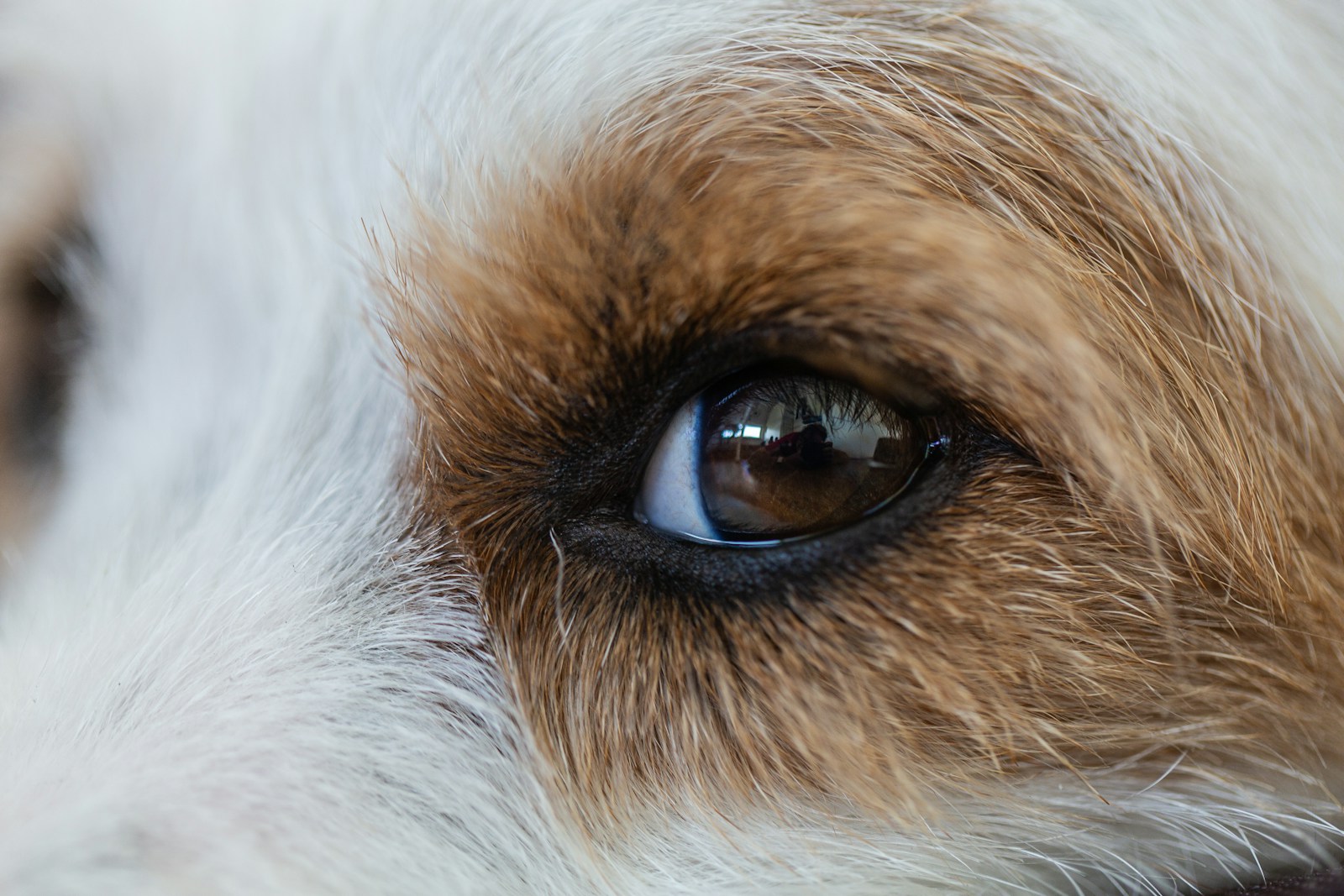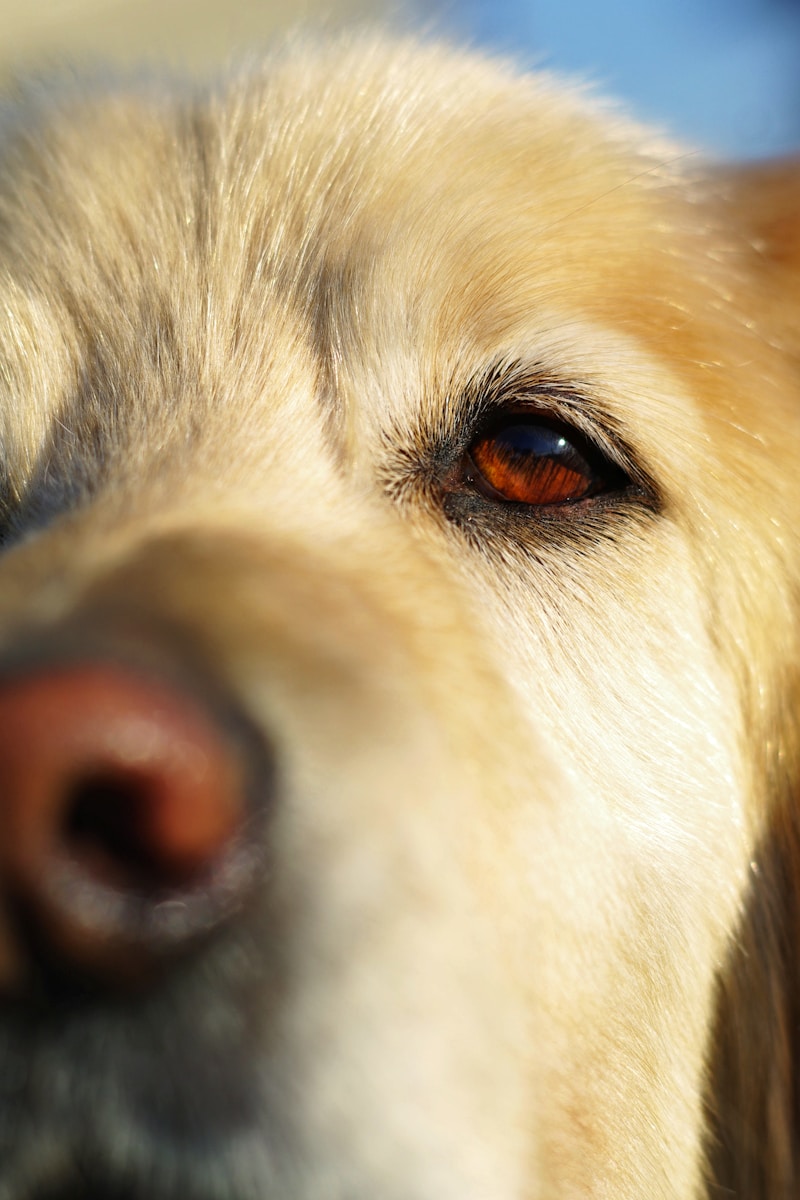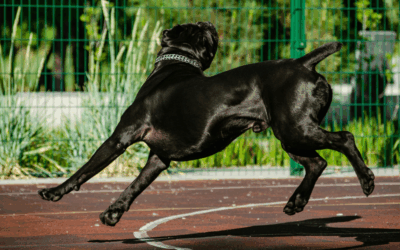Ever wondered how your furry friend sees the world? So, what color do dogs see?
Are those brightly colored dog toys as vibrant to them as they are to you? For years, many have believed that dogs only see the world in black and white, but science tells a fascinatingly different story. Understanding canine vision not only deepens our connection with our four-legged companions but also helps us make informed choices about their toys, training, and environment.
This blog will guide you through the unique aspects of a dog’s color perception, how a dog’s vision compares to humans, and the practical applications of this knowledge in your dog’s daily life.

Photo by Simon Hesthaven on Unsplash
The Science Behind Canine Vision
To understand what colors dogs can see, it’s essential to explore the makeup of their eyes. Both human and canine eyes contain photoreceptor cells called cones and rods:
- Rods are responsible for detecting light levels and motion, making them crucial for night and low-light vision. Dogs possess a higher number of rod cells than humans, enhancing their ability to see in dim light.
- Cones are responsible for color perception. Humans have three types of cone cells, which allow us to see a broad range of colors, including red, green, and blue. Dogs, however, have just two types, giving them what is known as dichromatic vision.

The Role of Rods in a Dog’s Vision
Rods are a type of photoreceptor found in the retina, and they play an essential role in how dogs perceive the world around them. Unlike cones, which are responsible for color detection, rods are highly sensitive to light and movement.
Dogs possess a significantly higher number of rod cells in their retinas compared to humans, giving them excellent vision in low-light conditions. This adaptation makes dogs well-suited for dawn and dusk activities, as they can detect subtle movement even in dim lighting.
Additionally, the abundance of rods allows dogs to excel at spotting motion, a trait that has been vital for their survival and hunting instincts over the course of evolution. While their reliance on rod-heavy vision means dogs do not see as many vivid colors, it highlights how their eyes are perfectly tuned for tasks requiring keen motion detection and night vision.
Understanding the role of rods in your dog’s eyesight helps clarify why their vision is ideal for certain conditions and how this impacts their daily behavior.
The Role of Cones in Dogs’ Vision
While rods dominate a dog’s retina, cones still play an essential role in their ability to perceive color and detail. Cones are the photoreceptor cells responsible for detecting different wavelengths of light, which allows for color discrimination.
However, dogs have only two types of cones compared to the three types found in human eyes. This difference means that dogs are dichromatic or have blue yellow color blindness, primarily perceiving shades of blue and yellow and struggling to distinguish between colors like red and green.
The limited number of cones also means that dogs’ vision is not as sharp when it comes to fine details, particularly in bright light conditions. Despite this, the presence of cones makes a significant contribution to their overall vision, enabling them to discern objects against contrasting backgrounds, especially in their primary visible color spectrum.
Understanding the roles of cones helps clarify why dogs have a unique visual perspective, emphasizing their capacity to adapt their eyesight to different tasks and environments.
What Colors Can Dogs Distinguish?
Are dogs color blind? While dogs are often thought to be completely colorblind, this is a myth. They can recognize some colors but in a more limited spectrum compared to humans. For instance:
- Dogs can discern blue and yellow hues effectively.
- They cannot perceive red and green as we do. Instead, red might appear as a dark brownish-gray or even black, and green grass might look yellowish.
This type of color blindness is similar to red-green color blindness in humans.
Simplifying the Colors
To put it simply:
- Colors like yellow, blue, and combinations of these two will stand out to your dog.
- Colors like red, orange, or green will appear muddy or muted.

Comparing Dog Vision to Human Vision
To truly appreciate a dog’s perspective, it helps to compare their vision to ours. Here’s how canine vision stacks up against human eyesight:
1. Color Range
Humans enjoy a broader range of colors due to having three types of cone cells. Dogs, with their two types of cone cells, perceive a more limited palette focused on blue and yellow.
2. Visual Acuity
Your dog’s vision is less sharp than yours. If you were to stand 40 feet away from an object, your dog would need to be about 20 feet away to see it with the same clarity. Think of it as having slightly blurry vision.
3. Motion Detection
Here’s where dogs shine. Thanks to their superior number of rod cells, dogs excel at detecting motion, even in low light. This trait stems from their ancestry as nocturnal hunters.
4. Peripheral Vision
Dogs have a wider field of view, around 250 degrees compared to the human average of 190 degrees, due to the positioning of their eyes.
5. Night Vision
With more rod cells and a reflective layer behind the retina known as the tapetum lucidum, dogs are far better equipped for seeing in dim light than humans

Why Understanding Canine Vision Matters
Knowing how your dog sees the world isn’t just an interesting fact; it’s incredibly practical when it comes to their overall well-being. Here’s how to apply this knowledge:
1. Choosing the Right Toys
When picking toys for your pup, skip the red balls and green chew toys. Instead, go for hues they can easily identify, like blue and yellow toys. For example:
- A blue ball will be easier for them to spot at the park.
- A yellow tennis ball will stand out much more than a red one.
2. Training and Play
Understanding color perception can improve training techniques. When using visual cues, opt for objects they can easily distinguish. This ensures your commands and training tools are as effective as possible.
3. Creating a Comfortable Environment
If you want your dog to feel at ease, consider how their limited color range impacts their daily environment. For instance, a green grass yard might appear yellowish to them, so adding blue toys could make their playtime more enjoyable.
Canine Vision in Unique Situations
Dogs’ incredible motion detection and low light vision also have fascinating implications. For example:
- They are more likely to chase moving objects, even in dim lighting.
- Their ability to detect subtle motion makes them excellent service animals and trackers.
- When navigating at night, their superior night vision gives them a distinct edge.
The Role of Health in Canine Vision
It’s worth noting that some health issues can affect your dog’s vision over time. Conditions like progressive retinal atrophy may reduce their ability to see clearly, particularly in low light. Regular vet check-ups are essential to ensure your dog’s eyes remain healthy.

Photo by Ryan Walton on Unsplash
Seeing the World Through Their Eyes
Imagine walking in your dog’s paw prints for a moment. The world, to them, is a canvas painted in shades of blue, yellow, and muted grays, with motion and low-light scenarios playing an equally vibrant role. While they might not experience the vivid greens and reds that we do, their ability to detect motion and thrive under dim light makes their vision uniquely suited to their needs.
Myths and Truths About Dogs’ Vision
There are numerous myths and misconceptions surrounding dogs’ vision, many of which stem from misunderstandings about how their eyes work. Below, we explore some of the common myths and truths about dogs’ vision:
Myth: Dogs can only see in black and white.
Truth: Contrary to popular belief, dogs are not colorblind in the sense that they only see in black and white. While their color spectrum is limited compared to humans, they can see shades of blue and yellow. This means that their world is not completely devoid of color, but rather appears in a more muted palette.
Myth: Dogs have poor eyesight overall.
Truth: Dogs’ vision is not inherently poor; it is simply adapted to their needs as predators. They possess exceptional motion detection and night vision, which are far superior to that of humans. However, their ability to focus on fine details or distinguish objects at a distance under bright light is less developed.
Myth: Dogs can’t see objects that are stationary.
Truth: While dogs are particularly adept at detecting movement, they can still recognize and focus on stationary objects. However, their sensitivity to motion often makes moving objects easier to notice and prioritize.
Myth: Dogs see the world in a blurry haze.
Truth: Though dogs’ visual acuity is lower than that of humans, it doesn’t mean their vision is entirely blurry. Their eyesight is perfectly suited to their survival needs, allowing them to spot movement and important features in their environment.
Dispelling these myths helps us better understand and appreciate the specialized nature of dogs’ vision. Their unique eyesight is a product of evolutionary adaptation, perfectly matched to their behaviors and daily lives.
Helpful Resources on Dog Color Vision
Here are six excellent resources to deepen your understanding of dogs‘ vision:
- American Kennel Club (AKC) – Understanding How Dogs See: Learn about the science behind canine eyesight, including the differences between human and dog vision. Visit the AKC website
- VCA Animal Hospitals – Dog Vision and Eye Care: A comprehensive guide on how dogs see the world and tips for maintaining their eye health. Explore VCA Animal Hospitals
- PetMD – How Dogs See Color: Discover how dogs perceive color and insights into how this impacts their behavior. Read the article on PetMD
- Science Focus – Can Dogs See Colors? This article by BBC’s Science Focus describes the science behind color vision in dogs. Read Science Focus’s article
- ASPCA – Common Eye Problems in Dogs: Learn about potential eye health issues in dogs and ways to address them effectively. Visit the ASPCA website
- National Geographic – How Animals See the World: Explore how various animals, including dogs, perceive the world differently than humans. Check out the National Geographic article

Helping Your Dog See the World Better | What Color Do Dogs See?
With this newfound knowledge of canine vision, you can enhance your dog’s daily life in several ways:
- Opt for yellow and blue toys to brighten their play sessions.
- Leverage their strong motion-detection abilities for interactive activities like fetch or agility training.
- Ensure regular eye health check-ups to prevent conditions like progressive retinal atrophy.
By seeing the world through your dog’s eyes, you’ll not only strengthen your bond but also create enriching experiences tailored specifically for them.



